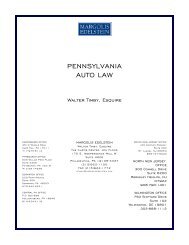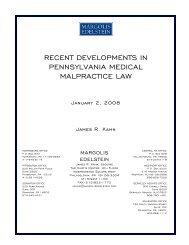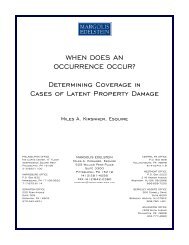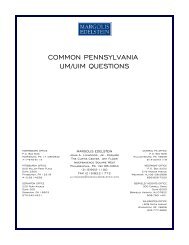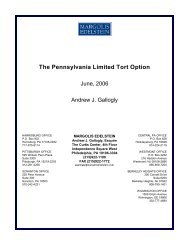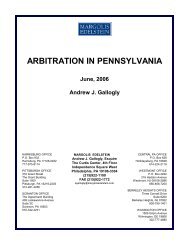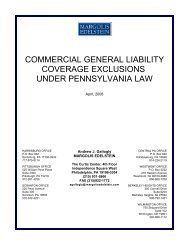selected topics in pennsylvania legal malpractice law - Margolis ...
selected topics in pennsylvania legal malpractice law - Margolis ...
selected topics in pennsylvania legal malpractice law - Margolis ...
Create successful ePaper yourself
Turn your PDF publications into a flip-book with our unique Google optimized e-Paper software.
2002); Sule v. W.C.A.B., 550 A. 2d 847 ( Pa. Cmwlth. 1988). An out of court statement by an<br />
attorney does not, however, b<strong>in</strong>d the client unless given expressly for the purpose of dispens<strong>in</strong>g<br />
with formal proofs at trial. The rule has been expressed as barr<strong>in</strong>g the <strong>in</strong>troduction of evidence of<br />
an attorney’s admissions made out of court and not <strong>in</strong> the presence of the client, unless authority to<br />
make them or knowledge or assent of the client is affirmatively shown. Eldridge v. Melcher, 226<br />
Pa. Super. 381, 313 A.2d 750 (1973).<br />
CAUSE OF ACTION FOR LEGAL MALPRACTICE<br />
The elements of a <strong>legal</strong> <strong>malpractice</strong> claim are 1) the employment of the attorney or other<br />
basis for duty, 2) failure of the attorney to exercise ord<strong>in</strong>ary skill and knowledge, and 3) such failure<br />
proximately caus<strong>in</strong>g damages to the pla<strong>in</strong>tiff. Hughes v. Consol-Pennsylvania Coal Company, 945<br />
F.2d 594 (3d Cir. 1991), cert. den’d, 112 S. Ct. 2300 (1992); Ste<strong>in</strong>er v. Markel, 600 Pa. 515, 968<br />
A.2d 1253 (2009); Rizzo v. Ha<strong>in</strong>es, 520 Pa. 484, 555 A.2d 58 (1985). An essential element to this<br />
cause of action is proof of actual loss rather than nom<strong>in</strong>al damages, speculative harm or the threat<br />
of future harm. Damages are considered remote or speculative only if there is uncerta<strong>in</strong>ty<br />
concern<strong>in</strong>g the identification of the existence of damages rather than the ability to precisely calculate<br />
the amount or value of damages. Rizzo, supra.<br />
In a litigation representation, “a <strong>legal</strong> <strong>malpractice</strong> action <strong>in</strong> Pennsylvania requires the pla<strong>in</strong>tiff<br />
to prove that he had a viable cause of action aga<strong>in</strong>st the party he wished to sue <strong>in</strong> the underly<strong>in</strong>g case<br />
and that the attorney he hired was negligent <strong>in</strong> prosecut<strong>in</strong>g or defend<strong>in</strong>g that underly<strong>in</strong>g case (often<br />
referred to as prov<strong>in</strong>g a ‘case with<strong>in</strong> a case’).” Kituskie v. Corbman, 552 Pa. 275, 714 A. 2d 1027<br />
(1998); Poole v. Warehouse Club, Inc. 570 Pa. 495, 810 A. 2d 1183 (2002); Epste<strong>in</strong> v. Saul Ew<strong>in</strong>g,<br />
7 A.3d 303 (Pa. Super. 2010). The attorney’s liability will not be established solely by proof that<br />
a bad result occurred <strong>in</strong> the underly<strong>in</strong>g action. Mazer v. Sec. Ins. Grp., 368 F. Supp. 418 (E.D.<br />
Pa. 1973), aff’d en banc, 507 F.2d 1338 (3d Cir. 1975). Even though a <strong>malpractice</strong> pla<strong>in</strong>tiff may<br />
face particular hardship by be<strong>in</strong>g forced to show she would have prevailed <strong>in</strong> the underly<strong>in</strong>g case,<br />
attorneys will face greater hardship and potential problems <strong>in</strong> the absence of such a rule. Gans v.<br />
Gray, 612 F. Supp 608 (E.D. Pa. 1985).<br />
CIVIL RIGHTS CLAIMS<br />
A crim<strong>in</strong>al defense attorney does not act under color of state <strong>law</strong>, even if court-appo<strong>in</strong>ted<br />
or employed by a public defender’s office, for purposes of meet<strong>in</strong>g the requirement for br<strong>in</strong>g<strong>in</strong>g a<br />
civil rights claim. A <strong>law</strong>yer represent<strong>in</strong>g a client is not, by virtue of be<strong>in</strong>g an officer of the court,<br />
a state actor “under color of state <strong>law</strong>”. This is essentially a private function, traditionally filled by<br />
reta<strong>in</strong>ed counsel, for which state office and authority are not needed. Polk County v. Dodson, 454<br />
U.S. 312, 102 S. Ct. 445 (1981). Although states license <strong>law</strong>yers to practice and although <strong>law</strong>yers<br />
are deemed officers of the court, such is an <strong>in</strong>sufficient basis for conclud<strong>in</strong>g that <strong>law</strong>yers act “under<br />
color of state <strong>law</strong>” for purposes of the Civil Rights Act. Henderson v. Fisher, 631 F.2d 1115 (3rd<br />
Cir. 1980).<br />
-3-



